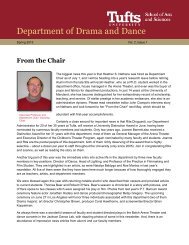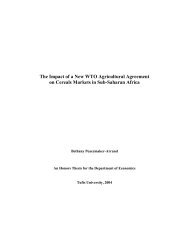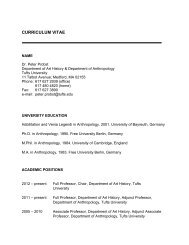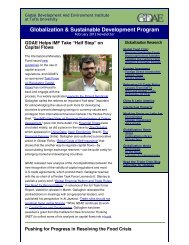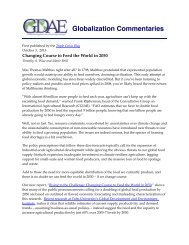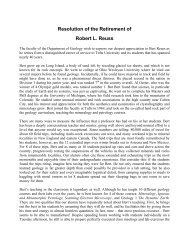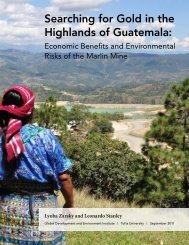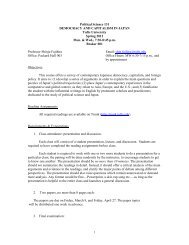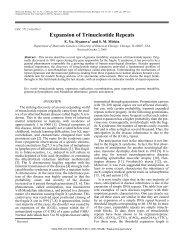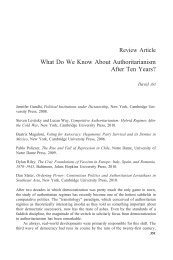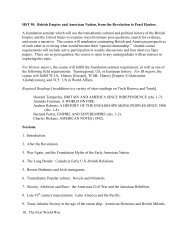Is A Main Street Program Appropriate for Mattapan? - Tufts University
Is A Main Street Program Appropriate for Mattapan? - Tufts University
Is A Main Street Program Appropriate for Mattapan? - Tufts University
Create successful ePaper yourself
Turn your PDF publications into a flip-book with our unique Google optimized e-Paper software.
to market the distinct nature of the district . An example event<br />
could be a “Taste of <strong>Mattapan</strong>” .<br />
• Balance <strong>Main</strong> <strong>Street</strong>s to the needs of the community: Consider a<br />
sub-committee <strong>for</strong> public safety, gentrification, or transit-oriented<br />
development . Depending on the number of volunteers, adding<br />
committees may be disadvantageous in which case one of the<br />
original four committees could instead focus on these issues .<br />
• Take results from the community planning phase to develop a<br />
strategic plan that is two-fold: Short-term visible change and<br />
overall long-term vision <strong>for</strong> the district<br />
PolICY IMPlICaTIons<br />
In<strong>for</strong>mation collected during this report indicates that while the <strong>Main</strong> <strong>Street</strong><br />
Four Point Approach is being applied with varying degrees of success, it<br />
can be a challenging framework to implement . This can be particularly true<br />
in urban communities that lack the volunteer base and have greater ethnic<br />
and economic diversity . While it is a relatively flexible framework, staffing<br />
all four committees can be challenging . The National <strong>Main</strong> <strong>Street</strong> Center<br />
should consider allowing communities to adapt the program to their specific<br />
needs . In addition, the primary analytical tool to measure the success of<br />
<strong>Main</strong> <strong>Street</strong>s has been economic statistics . More research is needed to<br />
evaluate both non-economic contributions of <strong>Main</strong> <strong>Street</strong>s as well as how<br />
and why programs fail . The National <strong>Main</strong> <strong>Street</strong> Center should review<br />
program outputs and conduct a <strong>for</strong>mative evaluation to determine how the<br />
different elements of the approach are working together .<br />
Our interviews indicate that each of the local Boston districts is implementing<br />
the <strong>Main</strong> <strong>Street</strong> program in a unique way . Yet certain issues such as<br />
funding and reliance upon volunteers appear common in many districts .<br />
The topic of in<strong>for</strong>mation-sharing arose in a few interviews, suggesting that it<br />
may also be helpful <strong>for</strong> the districts to learn more about what each is doing .<br />
In addition to the monthly meetings, more collaboration or improved communication<br />
among the districts may be advantageous as it would allow the<br />
executive directors to learn from and assist each other .<br />
sUGGesTeD fUTURe ReseaRCH<br />
Alternatives to <strong>Main</strong> <strong>Street</strong>s<br />
If community support <strong>for</strong> a <strong>Main</strong> <strong>Street</strong>s is infeasible or designation is<br />
denied by Boston <strong>Main</strong> <strong>Street</strong>s <strong>for</strong> a third time, we recommend pursuing<br />
a Business Improvement District (BID) . This is where property owners<br />
representing 75% of the property value within a commercial district vote to<br />
assess themselves a tax that funds services beyond the basic city ameni-<br />
32<br />
ties . Working through a board of directors the programs implement many<br />
of the <strong>Main</strong> <strong>Street</strong> principles while providing a stable funding source <strong>for</strong><br />
staffing and organizational initiatives . The legally binding entity would need<br />
legislative approval to be effective in <strong>Mattapan</strong> Square and would allow the<br />
various commercial nodes to plan collectively <strong>for</strong> their own development .<br />
A BID revitalized New York’s Times Square and could facilitate the <strong>for</strong>mation<br />
of new partnerships in <strong>Mattapan</strong> . It could also present to the <strong>Mattapan</strong><br />
Board of Trade (MBT) a measure of the local control that it does not want<br />
to give to the city through a <strong>Main</strong> <strong>Street</strong> program . In the process, MBT will<br />
demonstrate to the community its commitment to local growth and expansion<br />
and dispel the grumblings about its allegiance to the Square’s absentee<br />
landlords . It is important to note that attempts at a BID in Downtown<br />
Crossing have been unsuccessful in the past so further research regarding<br />
its potential is necessary .<br />
Alternatively, in addition to a <strong>Main</strong> <strong>Street</strong>s and a BID, the <strong>Mattapan</strong> Community<br />
Development Corporation could also consider simply launching a<br />
program that applies the principles of <strong>Main</strong> <strong>Street</strong>s without the name . <strong>Mattapan</strong><br />
stakeholders such as MCDC could create a coalition comprised of<br />
representatives from all of the commercial nodes, including River <strong>Street</strong> with<br />
its cluster of businesses . Working collaboratively, a representative sample<br />
of businesses from all of <strong>Mattapan</strong>’s commercial nodes can create a grassroots<br />
“blueprint” <strong>for</strong> the area’s commercial success . The concept of using<br />
the principles of <strong>Main</strong> <strong>Street</strong>s without the name is currently being applied<br />
by the city of Providence, Rhode <strong>Is</strong>land, through its Neighborhood Markets<br />
initiative . The municipality overtly acknowledges that it bases its approach<br />
on the <strong>Main</strong> <strong>Street</strong>s concept . It would also be an exciting opportunity <strong>for</strong><br />
observers to learn from such a partnership between MCDC and the businesses<br />
within its community .<br />
Greater Participatory Planning<br />
<strong>Mattapan</strong> is at a crucial point in terms of development . It is one of the few<br />
neighborhoods left in Boston with significant land available <strong>for</strong> development<br />
. With the city in the process of implementing MEDI, it is clear that major<br />
changes in the community are on the horizon . The <strong>Mattapan</strong> Community<br />
Development Corporation has the opportunity to become a lead voice in the<br />
future of <strong>Mattapan</strong> . A reoccurring theme from our discussions with residents<br />
was the perception that they have no voice in the development process .<br />
MCDC should investigate ways to incorporate more participatory planning<br />
. A potential model to consider is the Roxbury Master Plan, developed<br />
between 1999 and 2003 .<br />
Through a series of focus groups and community meetings, a master plan<br />
was developed by the community to guide decision making regarding<br />
neighborhood revitalization . The Roxbury Master Plan was adopted by the<br />
Boston Redevelopment Authority and the Roxbury Strategic Master Plan




